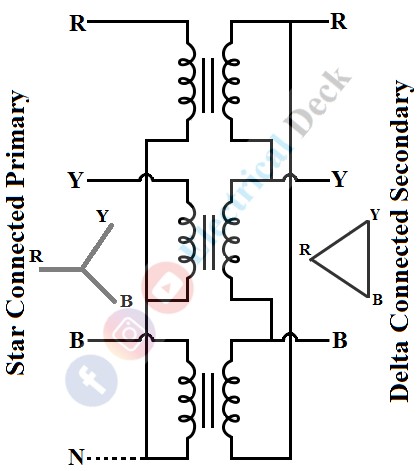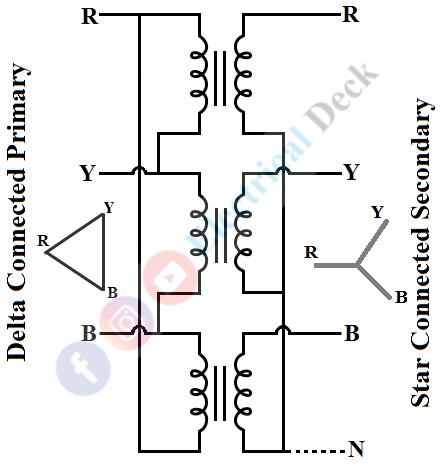In a single-phase as well as three-phase transformer the windings are placed on the core structure which is made up of a laminated steel core. This core structure which supports the two windings of the transformer is placed inside the transformer tank (immersed in the oil for cooling). The terminals of the primary and secondary windings are brought out through the transformer tank.
But before bringing out, the three windings (each winding for each phase) of primary and secondary are connected inside the transformer. Let us see the possible way of connecting the primary and secondary of a three-phase transformer.
The different connections used for three-phase transformer windings are :- Star-Star (Y - Y),
- Delta-Delta (Δ - Δ),
- Star-Delta (Y - Δ), and
- Delta-Star (Δ - Y).
Star-Star (Y - Y) Connection :
In a star-star type of connection, the terminals of a three-phase winding on both primary and secondary sides are connected in the shape of the letter 'Y'. Since, both primary and secondary windings are connected in the same manner (i.e., star). It is known as the Star-to-Star connection. This type of connection is most economical for transformers that work for small currents and high voltages.
Advantages of Star-Star Connection :
- In the star connection phase voltage Vph = 1 /√3 × line voltage. We can see that line voltage is √3 times the phase voltage this intern decreases amount of coil turns required per phase.
- The insulation required for windings is also decreased for coil turns which is most economical.
- The phase displacement between the primary and secondary voltages is almost zero. Hence both the primary and secondary voltages are in phase.
- Transformer windings with star connections are good enough to use when the load is balanced.
Disadvantages of Star-Star Connection :
- If there is no earthing connected to the neutral star point of the load side winding. It is difficult to control the phase voltage on the load side when the load is unbalanced. This can be overcome by connecting the neutral point (star point) of the primary winding to the neutral point of the generating station.
- The waveform of the flux in the transformer core gets distorted if there is no proper neutral point connected to the primary winding. Because the transformer cannot draw its third harmonics part. Hence there can be a change in the magnitude of the magnetizing current and produces harmonics in supply voltage.
Delta-Delta (Δ - Δ) Connection :
In this type of connection, the end of one coil of a three-phase winding is connected to the end of the other coil. In this way, the three coils are connected such that it forms a shape delta. The delta-connected windings can generate large currents with low values of voltages. The below figure shows the Δ - Δ connections and voltage triangles.
Advantages of Delta-Delta Connection :
- There is no phase displacement between the primary and secondary voltages.
- In delta connected winding third harmonics can flow without any neutral point connected. Therefore, the chances of distortion in the waveform of the flux will be less.
- The phase current is reduced by √3 times. Hence the current carrying capacity of the conductor decreases thereby reducing the overall cost of the conductor.
- This connection can work satisfactorily when the load is unbalanced compared to the star connection.
- Continuity is more i.e. if one of the phases is removed (fault) in Δ - Δ connection, operation continues on open-delta (or in V - V) with reduced (58%) capacity.
Disadvantages Delta-Delta Connection :
- In Δ - connected winding line voltage is equal to the phase voltage. This increases the insulation cost required when compared to Y - Y connection.
- This type of connection is not suitable for distribution purposes where there is a need for a return path (neutral point).
Star-Delta (Y - Δ) Connection :
This type of winding connection is used where we need to decrease the voltages levels, for example, at the end of a transmission line. Here, the neutral of the transformer's primary winding is earthed.
In this system transformation ratio, K is equal to the ratio of secondary phase voltage to the primary phase voltage. Also third harmonic current flow in the Δ - connected winding can control the system even when it is unbalanced with minimized distortion in the waveform of the flux.
On the primary side of the transformer, the winding is connected in a star. Here in the star connection line voltage is √3 times of phase voltage which decreases the effective use of per phase insulation required. But there will be a phase displacement between the primary and secondary voltages.
Delta-Star (Δ - Y) Connection :
It is a combination of delta-connected winding on the primary side and star connection on the secondary side as shown below. The delta-star connection can be used where there is a need in increasing the voltage levels or stepping up.
This type of connection is well suited for distribution purposes due to the availability of a 3-phase, 4-wire system at the secondary side. But limited to its applications due to the existence of a phase shift between primary and secondary winding.




